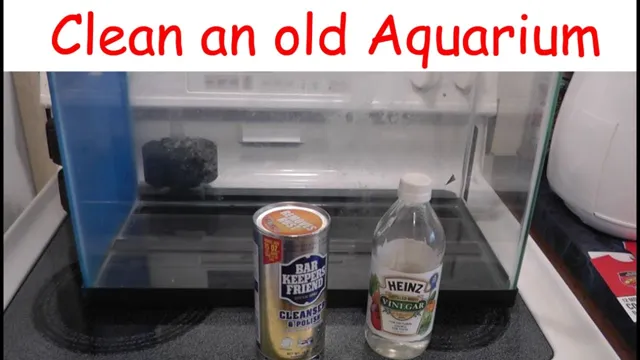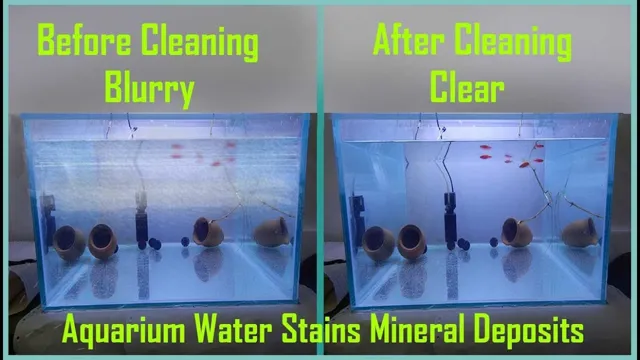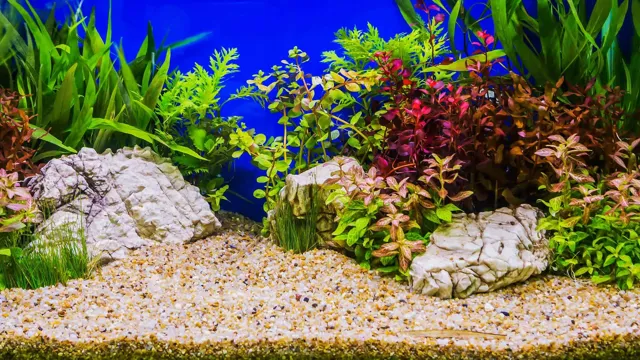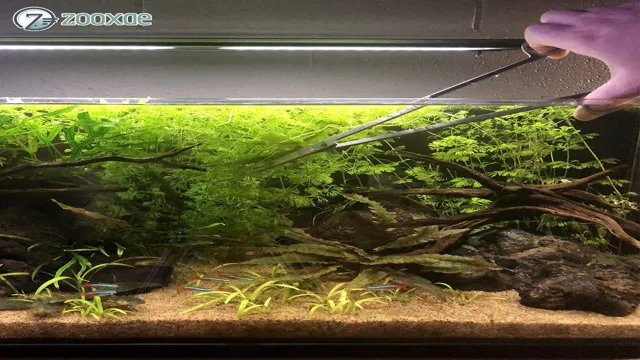If you are a proud owner of an aquarium, then you know how important it is to maintain its cleanliness. However, despite your best efforts, you may notice mineral deposits starting to accumulate in your tank. These white, crusty deposits not only look unsightly but can also harm the health of your fish and plants.
But don’t fret! In this blog post, we will show you how to get rid of mineral deposits from your aquarium and keep it clean and healthy for your aquatic pets. First, let’s understand what causes mineral deposits in an aquarium in the first place. Hard water, which contains high levels of minerals such as calcium and magnesium, is a common culprit.
These minerals can build up in your tank over time, especially if you use tap water for your aquarium. When the water evaporates, the minerals are left behind, forming a white, crusty layer on the glass, decorations, and substrate. So, how do you remove these pesky deposits? One way is to use a scraper or a razor blade to physically scrape them off.
However, this method can be time-consuming and can potentially scratch your aquarium’s glass. Alternatively, you can use a mixture of vinegar and water to dissolve the deposits. Simply make a solution of equal parts water and white vinegar, put it in a spray bottle, and spray it onto the affected areas.
Let it sit for a few minutes, then use a soft-bristled brush to gently scrub the deposits away. In addition to removing existing mineral deposits, it’s essential to prevent them from forming in the first place. You can do this by using distilled or purified water for your aquarium or installing a water softener to reduce the mineral content in your tap water.
Regular water changes (about 10% to 20% every week) and cleaning the tank’s filter will also help prevent mineral buildup. Keeping your aquarium clean and free of mineral deposits is necessary for the health and well-being of your fish and plants. By following these simple tips, you can maintain a beautiful and healthy aquatic environment for your pets to thrive.
Understanding Mineral Deposits
Aquariums are a great way to bring the peaceful tranquility of underwater life into your home. However, over time, mineral deposits can build up and affect the clarity of the water and overall health of the aquatic life. The best way to clean mineral deposits from your aquarium is by using a gentle, non-toxic cleaning solution and a soft brush.
White vinegar is an excellent natural solution that can effectively remove mineral buildup without harming any plants or animals in the tank. Simply dilute the white vinegar with water, dip the brush into the solution, and gently scrub away any deposits from the glass or decorations. Be sure to rinse thoroughly with fresh water afterwards to prevent any lingering vinegar residue.
With a little care and maintenance, your aquarium will look crystal clear and keep its inhabitants healthy and happy.
Identifying the Different Types of Mineral Deposits
Mineral deposits are naturally occurring geological formations of minerals found in the Earth’s crust. They are usually found in concentrated areas and have unique characteristics that distinguish one deposit from another. There are different types of mineral deposits, and their formation can be influenced by a variety of factors, including the temperature, pressure, and chemistry of the fluids that are responsible for their deposition.
The most common mineral deposits are metallic, non-metallic and fuel. Metallic mineral deposits include copper, iron, gold, silver, nickel, and zinc while non-metallic mineral deposits consist of rocks such as gypsum, salt, and diamonds. Fuel deposits primarily comprise coal, oil, gas, and tar sands.
Understanding the various types of mineral deposits is important for those who are engaged in mineral exploration, mining, and extraction activities. Each type of deposit requires different extraction methods, and determining the most efficient and cost-effective way to extract minerals is crucial for successful operations. Overall, identifying and categorizing mineral deposits is integral to the mining industry, which plays a significant role in the global economy.

Causes of Mineral Deposits in Aquariums
Mineral deposits in aquariums can be caused by a variety of factors, but one of the main culprits is the water that you use. Depending on the type of water you have in your area, there may be minerals present that can build up over time and form deposits on the walls of your aquarium. Another factor is the build-up of leftover fish food and waste, which can also contribute to mineral deposits if left unchecked.
One way to prevent mineral deposits is to regularly clean your aquarium and replace the water with fresh, filtered water that has been treated to remove any impurities that may contribute to the problem. It’s important to keep a close eye on the pH levels of your aquarium, as a fluctuation in pH can also lead to the formation of mineral deposits. By understanding the causes of mineral deposits, you can take the necessary steps to prevent them and ensure that your aquarium remains a healthy and vibrant environment for your fish to thrive in.
Tools and Materials Needed for Cleaning
If you’re struggling with mineral deposits in your aquarium, cleaning can seem daunting, but with the right tools and materials, it’s doable. You’ll need some white vinegar, a scrub brush or sponge, and a little elbow grease. First, remove any fish or other creatures from the tank and drain the water.
Then, using the vinegar and brush or sponge, gently scrub away any buildup. For hard-to-reach areas, consider using a toothbrush or cotton swab. Once you’ve cleaned the tank thoroughly, rinse it out with clean water and refill. (See Also: How Soon Can You Put Fish in a New Aquarium Without Harming Them?)
Remember to check the pH of the water before re-adding any fish or creatures. With these simple tools and a little effort, cleaning mineral deposits from your aquarium is easier than you’d think!
Safety Precautions to Follow When Cleaning Your Tank
When it comes to cleaning your tank, safety should always come first. Before gathering the tools and materials needed, it’s important to take certain precautions. Make sure the tank has been emptied of all its contents and unplugged from any electrical sources.
Wear protective clothing such as gloves and eye protection to avoid any harm or injury from the cleaning process. When dealing with chemicals or harsh cleaning agents, make sure the area is well-ventilated to avoid inhaling any toxic fumes. Now that safety is considered, let’s cover the tools and materials that are needed for cleaning your tank.
The most basic tools needed are a scrub brush, a siphon vacuum, a bucket, and a hose. For tougher stains and dirt buildup, you may consider investing in a specialized aquarium cleaning brush or scraper. Additionally, specific cleaning agents may be necessary for removing algae or other debris, but make sure to check that these chemicals are safe for your fish and plants before using them.
A gravel cleaner is also recommended for removing debris from the substrate. Finally, keep a towel or rag handy for any spills or messes during the cleaning process. By taking the appropriate safety measures and having the right tools on hand, cleaning your tank can be a hassle-free and effective process.
Essential Tools for Cleaning Mineral Deposits
When it comes to cleaning mineral deposits from household surfaces, having the right tools and materials is essential. You will need a few basic items to get started, such as gloves, safety glasses, and a respirator mask to protect yourself from any harmful chemicals or dust. Other essential cleaning tools include a stiff-bristled brush, a plastic scraper, and a bucket for mixing cleaning solutions.
When it comes to the cleaning solutions themselves, you may need to use vinegar, baking soda, or a commercial cleaner designed specifically for mineral deposits. Depending on the severity of the buildup, you may also need a pumice stone or scouring pad to scrub away tougher deposits. By having the right tools and materials on hand, you can tackle even the most stubborn mineral deposits with ease and keep your home looking its best.
Step-by-Step Guide to Removing Mineral Deposits
If you’re one of those aquarium owners who struggle with unsightly mineral deposits, you’re not alone. These mineral buildups typically occur due to hard water and can pose a problem for fish health and water quality. Fortunately, removing mineral deposits from your aquarium is a relatively easy process.
To begin, ensure that your aquarium is empty and drained of water. Once it’s completely empty, start by dipping a soft brush or cloth into a mild acid solution like vinegar and gently scrubbing the affected areas. You can also use a commercial mineral deposit remover specially designed for aquariums.
Be sure to follow the manufacturer’s instructions closely to prevent any damage to the tank or fish. After scrubbing, rinse the tank thoroughly with fresh water and let it air dry. Lastly, refill your aquarium with fresh water and treat it with appropriate chemicals to ensure the perfect balance for your fish and vegetation.
By following these steps regularly, you can keep your aquarium clean, healthy, and free of unsightly mineral deposits.
Draining Your Aquarium Safely and Effectively
Draining your aquarium is a crucial task that should be done safely and effectively. One of the most important steps in this process is removing mineral deposits that have built up over time. These deposits can lead to a variety of issues, such as cloudy water, algae growth, and damage to fish and plants.
To remove mineral deposits from your aquarium, start by turning off all equipment and unplugging any electrical devices. Then, use a siphon hose to drain the majority of the water from the tank. Once the water level is low, use a scraper or cleaning pad to gently remove any visible mineral deposits from the glass surfaces.
Finally, rinse the tank thoroughly with fresh water and use a water conditioner to neutralize any remaining deposits. By following these simple steps, you can keep your aquarium clean, healthy, and free from mineral buildup. (See Also: How to Get Rid of Snail Eggs on Aquarium Plants: Tips and Tricks)
Scraping and Scrubbing Mineral Deposits from Hard Surfaces
Scraping and scrubbing mineral deposits can be a difficult task, and it’s important to do it correctly to avoid damaging the surface underneath. Here’s a step-by-step guide to help you remove those pesky mineral deposits from hard surfaces. First, gather your tools.
You’ll need a plastic scraper, scrub brush, white vinegar, and a bucket. Start by pouring the white vinegar onto the affected area and letting it sit for a few minutes. The acidity of the vinegar will help break down the minerals.
Then, use the plastic scraper to gently scrape the mineral deposits off the surface. Be careful not to put too much pressure and scratch the surface. Once you’ve scraped off as much as possible, use the scrub brush to further loosen any remaining mineral deposits.
Finally, rinse the surface with clean water and pat it dry. With patience and the right tools, you can easily remove mineral deposits without causing damage to your hard surfaces.
Safely Removing Mineral Deposits from Delicate Surfaces
If your delicate surfaces have been stained by mineral deposits, don’t worry – there are safe and effective ways to remove them without damaging your surfaces. Here’s a step-by-step guide to removing mineral deposits: 1) Identify the affected surface and the type of mineral deposit. Different minerals require different removal methods, so it’s important to know what you’re dealing with.
2) Use a mild solution of vinegar and water to soften the mineral deposits. Apply the solution with a soft sponge or cloth and let it sit for a few minutes. 3) Gently scrub the affected area with a soft-bristled brush.
Be careful not to scrub too hard, as this can damage the surface. 4) Rinse the surface with clean water to remove any remaining residue. Repeat the process if necessary.
5) For stubborn mineral deposits, try using a commercial mineral deposit remover. Be sure to follow the instructions carefully and test the product on a small, inconspicuous area first. Remember to always take precautions when working with cleaning solutions and to protect your hands and eyes.
By following these simple steps, you can safely remove mineral deposits from your delicate surfaces and restore them to their original beauty.
Preventing Future Mineral Deposits in Your Aquarium
If you’re tired of constantly cleaning mineral deposits from your aquarium, the key is to prevent them from forming in the first place. One way to do this is by regularly testing the pH levels in your water and adjusting them as necessary. Keeping the pH at a stable level can help prevent minerals from building up on surfaces and equipment.
Another way to prevent mineral deposits is by using a water softener or reverse osmosis system to purify the water before adding it to the aquarium. Additionally, regularly cleaning your aquarium and its equipment can help remove any existing minerals and prevent new ones from forming. By taking these steps, you can enjoy a clean and healthy aquarium without the hassle of constantly cleaning mineral deposits.
Tips for Maintaining Water Quality
Maintaining water quality is important for the health and well-being of any aquarium. One important aspect of this is preventing mineral deposits from forming in the tank. These deposits can be unsightly and can also cause damage to the plants and fish living in the aquarium.
To prevent mineral deposits, it’s best to use a good water conditioner and keep an eye on the water levels in the tank. Regular water changes can also help keep the tank clean and free of any build-up. Additionally, testing the water regularly to check for any imbalances in pH or other levels will help prevent future problems.
By taking these steps, your aquarium will stay healthy and clear, and you’ll be able to enjoy watching your fish and plants thrive. So, keep up the good work and ensure your aquarium’s water quality stays at its best!
Avoiding Common Causes of Mineral Deposits
Mineral deposits are one of the most common issues that aquarium owners face. These deposits can cause a variety of problems, including unsightly buildup on tank surfaces, poor water quality, and damage to equipment. Fortunately, there are several things you can do to prevent future mineral deposits in your aquarium. (See Also: How to Grow a Planted Aquarium: Tips and Tricks for a Thriving Aquatic Garden)
One of the most important things is to use high-quality water. This means using a water filter to remove impurities and minerals. Additionally, you should avoid overfeeding your fish, as excess food can contribute to the buildup of organic matter in the tank.
Finally, it’s important to clean your tank regularly, removing any debris or buildup that may be present. By taking these simple steps, you can help ensure that your aquarium remains healthy and free from mineral deposits.
Conclusion and Final Thoughts
Cleaning mineral deposits from an aquarium can be a tough task, but with the right approach and tools, it can be a piece of cake. Remember, prevention is better than cure, so stay ahead of the game by regularly cleaning and maintaining your aquarium. And if you do encounter stubborn mineral deposits, be patient, and don’t lose your cool.
With a little bit of elbow grease and some clever tricks up your sleeve, you’ll have your aquatic oasis looking crystal clear in no time. So go ahead, give your fish a sparkling home, and bask in the satisfaction of a job well done!”
FAQs
What causes mineral deposits to build up in an aquarium?
Mineral deposits can build up in an aquarium due to hard water, evaporation, and lack of regular maintenance.
How can I tell if my aquarium has mineral deposits?
You might notice white or yellowish buildup on the glass or decorations, reduced water flow, or a decrease in the efficiency of your heater or filter.
Can mineral deposits harm my fish or plants?
Excessive mineral buildup can affect the water chemistry and potentially harm your aquatic pets or plants, so it’s important to address the issue.
What is the best way to remove mineral deposits from an aquarium?
You can use a variety of methods, such as vinegar, citric acid, or a commercial descaler, to safely remove mineral deposits from your aquarium.
How often should I clean my aquarium to prevent mineral buildup?
To prevent mineral buildup, it’s recommended to perform regular water changes and cleanings, ideally every two to four weeks.
Can I use tap water to clean my aquarium?
While tap water can be used for cleaning, it’s important to use a water conditioner to neutralize chlorine and other chemicals that can harm your aquatic pets.
Is it necessary to completely empty my aquarium to remove mineral deposits?
While it’s not always necessary, it can be helpful to perform a partial or complete water change to thoroughly remove mineral deposits and maintain a healthy environment for your aquatic pets.







